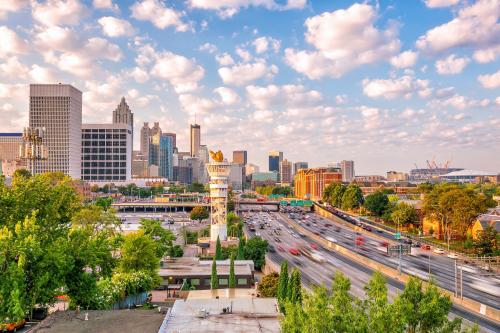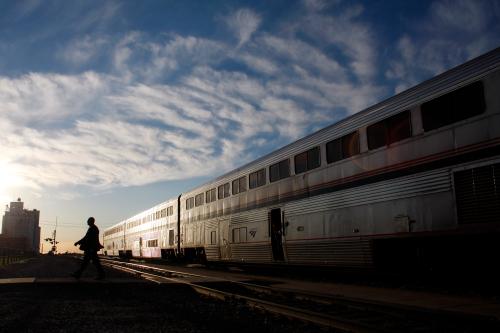As the COVID-19 recession deepens, many households are struggling to keep up with basic costs of living. Housing, food, and health care are just a few costs pressuring those who may have lost jobs, fallen ill, or were already carrying a lot of debt. Lower-income, indebted households are especially vulnerable.
Amid shelter-at-home orders and social distancing, one of the least obvious but most significant costs vulnerable Americans face is transportation. Even though we’re not driving, buying gas, or taking transit as much—all of which usually make transportation the second-highest average household expenditure annually—many of us are still dealing with the costs of owning a car. Specifically, individuals carrying costly car loans are financially vulnerable and exposed to losing the physical access to opportunity that comes with car ownership.
Marooned in far-flung suburbs, Americans often have no choice but to drive everywhere. And we pay for it, from car repairs to insurance to loans. While the country isn’t rushing to buy new cars right now and insurance companies are offering refunds to compensate for our lower mileage, existing car loans are still a big burden for millions of lower-income Americans who took on more debt in the last few years and now face greater health and job risks during the current recession. The downstream impacts—stretched budgets, missed payments, and less consumption overall—could create a drag on a wider economic recovery.
Before the coronavirus hit this March, Americans had almost 116 million car loan accounts—totaling $1.3 trillion, or about $11,476 each, according to New York Federal Reserve Bank data. This ranks them among the biggest categories of debt nationally; there are now more car loan accounts than mortgages (81 million).
Car loans are also one of the fastest-growing categories of debt nationally. The total outstanding value of car loans is up almost $395 billion in inflation-adjusted terms (or 55%) since 2009—higher than every debt category except student loans (up $544 billion, or 75%).

While higher-income individuals do not rely as much on car loans and have benefited from not needing to travel as much during the current pandemic, lower-income individuals have not been as fortunate. Several recent reports have examined increased borrowing and predatory lending to lower-income individuals over the past decade, including longer loan terms and higher-cost subprime loans (those made to individuals with lower credit scores). Now, lower-income individuals are not only more likely to be deemed “essential” and commute to work, but they are also saddled with car loans lasting up to 84 months and being forced to seek more payment deferrals.
Many of these lower-income individuals were already in a pinch before COVID-19. From 2009 to 2019, subprime borrowers (those with credit scores below 620) took on more car loans. The volume of car loan originations for this group jumped from $11 billion to almost $26 billion in real terms—a 127% gain, faster than all other borrowers. In other words, borrowing kept growing despite the economic risks, and while some of these loans are now paid off, many borrowers are still on the hook to their lenders.

These car loans are also widespread. Using data organized by the Urban Institute’s “Debt in America” series, it’s possible to see how borrowers across the country’s 192 largest metro areas are faring. Nationally, 31% of Americans have a car loan, but these rates are often higher across the country’s largest metro areas, where driving to distant jobs and other services has become a daily reality. In 112 of the 192 largest metro areas, car loan rates were higher than the national average, including sprawling metro areas such as Buffalo, N.Y. (38.7%), Omaha, Neb. (37.5%), and Tampa, Fla. (33.4%). In contrast, denser, urban metro areas offering greater transportation choice—such as New York (22.6%) and San Francisco (23.6%)—have among the lowest rates, as do many college towns, including Boulder, Colo. (25.5%) and Eugene, Ore. (27.4%).

Car loans are not going away anytime soon, even as we drive less and buy fewer vehicles during the pandemic. This debt continues to take a toll on millions of borrowers across the country at a time when the economy is struggling to regain its footing. Even if they have not lost their job—and many have—lower-income individuals are among the hardest hit. Stimulus checks and loan forbearances have helped manage the daily costs of living, but these are temporary solutions at best.
Supporting households with high transportation costs would be a good first step. While other escalating costs, including housing and student loans, are concerning and require more attention, infrastructure affordability is often overlooked by national and local policymakers. We need to better measure and address the escalating transportation costs that households have to cover, while continuing to discuss the affordability of water, broadband, and other infrastructure services. Customer assistance programs might make a difference, as they have for other services, but we need to better understand the scale of the transportation affordability challenge—which goes beyond car loans—and target resources for individuals in greatest need.
Providing greater transportation choice is also a must in years to come. Decades of bad planning and community design have forced many Americans to keep owning a vehicle, but there is potential to take advantage of the current coronavirus moment as we drive less and encourage a broader range of transportation options. Rather than jumping back in our cars and continuing to take on more loans, why not invest in places that promote greater walkability and freedom of movement instead? In the many communities where walking and transit cannot work, however, individuals should have more affordable options to access vehicles without owning them. Safer rental and ride-hailing possibilities are a potential strategy.
Protecting borrowers would help as well. Fair lending practices, including anti-discrimination measures and negotiable loan terms, could make a difference for subprime borrowers who are targets for costly loans. The Consumer Financial Protection Bureau has strengthened regulations and released guidance on car loans to prevent borrower discrimination, but more recent congressional action has aimed to deregulate borrower protections. If anything, we need more robust protections during and after the pandemic.
Our transportation affordability challenge is not isolated to the current recession, but we should address it now to aid in our recovery. As the economy begins to open again, people need to get back to work and physically access opportunity with greater financial certainty. Reducing the impact that car loans have on our ability to do so should be a key policy consideration. Otherwise, we are only setting ourselves up for more costs and risks into the future.







Commentary
Costly car loans may stall the COVID-19 economic recovery
May 11, 2020